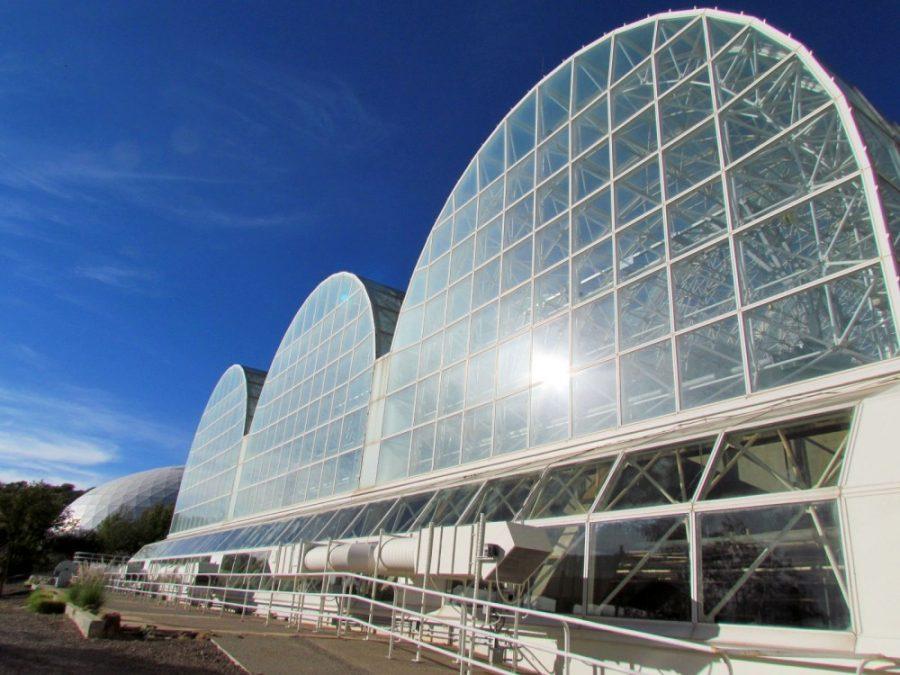Although water and energy tend to be viewed separately, the two are undeniably connected, and researchers at the UA’s Biosphere 2 intend to prove it.
Researchers working with the Model City program at Biosphere 2 are exploring ways to synthesize water and energy in a sustainable fashion that can have applications in real cities. Called the “watergy” project by the researchers, their ultimate goal is to coordinate the unpredictable demands for water with the production of solar energy.
Biosphere 2 is a microcosm of an actual city, said Nate Allen, coordinator of the Model City research program. The energy and water usage in the Biosphere itself is comparable to that of an industrial area, while the demands of the administrative building and conference center are similar to those of a commercial business zone. The Biosphere’s 30 casitas, which can house researchers or people attending conferences, are akin to a residential area.
“We know that it’s not a real city,” Allen said, “but we think it’s close enough that it allows us to do experiments that we think what we learn will be scalable and applicable to real cities. It’s a bridge between desktop research and actual application.”
One of the ways that Biosphere researchers bridge the gap between the lab and the real world is by examining the relationship between water and energy and then figuring out real-world applications of their findings. Researchers are studying how to predict the sunny days that power solar panels, which could help them determine when they should or shouldn’t run energy-intensive machines like water pumps. This solar forecasting is being conducted because unlike with traditional energy sources, renewable energy output is hard to predict and therefore hard to regulate.
“When you throw a ton of coal into a generator, it creates electricity that’s very even,” Allen said. “Renewables are not that way. With solar panels, a cloud goes over, the sun goes down, the wind stops blowing — any number of things (make) the power come on and off and on and off.”
At the moment, the solar panels at Biosphere 2 can offset about 10 percent of the electrical load at noon on sunny days, said Dani DellaGiustina, a research technician for the project.
DellaGiustina will try to coordinate the variable supply of solar power with the demand for water, which is unpredictable because people don’t always use the same amount of water at the same time every day. The plan is to eventually create control algorithms for Biosphere 2’s water pumping system that will coordinate the variable demands for water with the variable supply of solar energy, DellaGiustina said. This strategy would optimize Biosphere 2’s large-scale water pumps, which move water from two wells into reservoirs for a combined capacity of 500,000 gallons.
Although the watergy research is in its early stages, Tucson’s many sunny days make Biosphere 2 an ideal testing ground for solar forecasting.
“We can start off really, really simply, and why shouldn’t we?” DellaGiustina said. “If we know we’re going to have a perfectly clear day, let’s just take advantage of all that free power we’re getting.”
Part of the reason that DellaGiustina and other Biosphere 2 researchers are doing solar forecasting is because Tucson Electric Power wants to incorporate more solar energy into its portfolio, she said.
Getting the prices right on renewable technologies is the key to their success, assistant economics professor Derek Lemoine said. Making solar energy cost-effective for companies as well as residents doesn’t mean subsidies, though. Instead, policy changes will help cast renewable energy in a more positive light.
“Prices need to push on every dimension at one time,” Lemoine said, referring to not only monetary costs but also the effect of energy use on the environment.
DellaGiustina echoed Lemoine’s view. She cited Idaho Power as a company whose energy output is partially dependent on wind energy, and said that policies were changed to accomplish that.
“There’s a lot of really interesting regulations that make it very difficult to incorporate renewables, because you have to have so much confidence in the amount of power that you’re going to have available,” she said.
If there’s an unexpected power outage, for example, a company such as TEP can quickly buy power from another company, she said. Drops in solar and wind energy, however, are not considered true power outages by many power companies. If they were, renewable energy would be more attractive on a commercial level.
To create a brighter, greener future, researchers at Biosphere 2 recognize that they have to find a way to make their technology widely accessible.
“We think [the research] will be a compelling way to make progress in making cities more intelligent, more sustainable, improve services and quality of life for the citizens and hopefully renew the environment a little bit,” Allen said. “What drives the economy is innovation, not austerity.”









